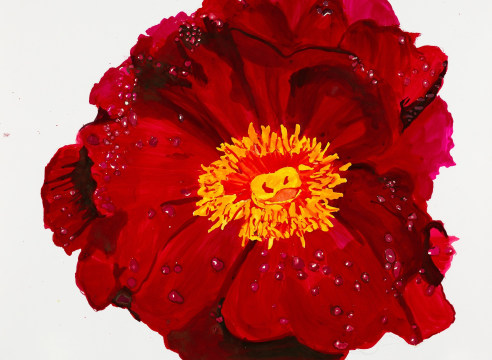
Sharon Core’s intricately layered and meticulously crafted images explore the interplay between reality and illusion, authenticity and artifice, representation and reproduction. By recreating still-lifes, sculptures and other compositions inspired by a variety of artworks, she interrogates notions of authorship and the constructed nature of images. Through her rigorous process, from growing rare botanical specimens to sourcing antique objects, Core produces images that are as much about their method of production as they are about the subjects they depict, thus challenging photography’s ties to objectivity.
In Thiebauds (2003–2004) and Oldenburgs (2004–2005), Core examines the intersection of painting, photography, and sculpture through the lens of food, a subject that straddles both artistic tradition and commercial culture. In Thiebauds, she bakes and arranges cakes, pies, and pastries to recreate Wayne Thiebaud’s iconic, impasto-laden paintings, translating his painterly textures into a tangible form. This exploration into cultural memory continues in Oldenburgs, where Core reconstructs Claes Oldenburg’s oversized, roughly hewn food sculptures—hamburgers, ice cream cones, slices of cake—in edible form before photographing them. The oversized prints further amplify the uncanny effect, making the objects appear at once real and strangely fabricated—they teeter between appearing delicious and grotesque. By reimagining these works through photography, Core exposes the ways food, like art, is both aestheticized and commodified, questioning how visual culture shapes perception, desire, and what we accept as “real.”
In Early American (2007–2010), Flowers 1606-1907 (2011–2012), and Understory (2014–2016), Core reconstructs historical still-lifes, examining the relationship between photography, illusionism and trompe l’oeil to create what the artist has described as an “extreme kind of pictorialism.” For Early American, she grew varieties of fruits and vegetables in existence in the 19th-century and collected period porcelain and glass, replicating the lighting and subject matter to recreate Raphaelle Peale’s muted compositions. Expanding this inquiry in Flowers 1606-1907, Core recreated floral still-lifes spanning three centuries, cultivating the flowers herself and then photographing them, as a way of resurrecting what she describes as a “dead genre.” This tension between the natural and artificial deepens in Understory, where she cultivated a living ecosystem in her studio, inspired by Otto Marseus van Schriek’s 17th-century forest-floor paintings. Mushrooms glow in shadowy undergrowth, vines twist through beams of light, and beetle wings shimmer in the gloom. In these photographs, there exists a palpable tension between the real and the imagined, the past and present, which are in a constant state of negotiation.
In her most recent series Facsimile (2021-2024), Core subverts her usual process of translating paintings into photographs, instead transforming Irving Penn’s celebrated photographic studies of flowers into unique, hand-painted recreations. Each of Penn’s photographs from Flowers, published in 1980, has been recreated as a painting using Epson Ultrachrome inks on Canson Photo Rag paper—materials typically associated with digital photographic printing. Through this method, Core subverts the intended use of contemporary materials, transforming them into tools for painting. She then photographed her painted pages, designed a layout replicating that of the original book, and bound the final prints into an edition of seven. Penn’s now out-of-print book is given a new lease of life, taking on a different meaning through a complex process of conversion: transforming photographs into paintings, which are then re-photographed, printed and bound into a book. Rather than questioning the boundaries of illusion and reality, Core emphasizes the handcrafted nature of all photographs. With Facsimile, Core continues to question notions of authenticity, materiality, and the evolving nature of representation in the digital age.
Sharon Core was born in New Orleans, Louisiana in 1965. She received her BFA in painting from the University of Georgia in 1987 and her MFA in photography from Yale University School of Art in 1998. Core began exhibiting her photographs in New York City in 1998 and has since shown her work in numerous solo and group exhibitions both in the United States and abroad. Her work is included in major public collections including the Solomon R. Guggenheim Museum, New York; J. Paul Getty Museum, Los Angeles; The National Gallery of Art, Washington DC; Amon Carter Museum of American Art, Fort Worth; The Phillips Collection, Washington DC; The Cleveland Museum of Art, Ohio; Los Angeles County Museum of Art, California; National Museum of Women in the Arts, Washington DC; Columbus Museum of Art, Ohio. She was the recipient of the Rema Hort Mann Foundation Art Grant in 2000. Her monograph,Sharon Core: Early American, was published by Radius Books in 2012. The artist lives and works in Esopus, New York.